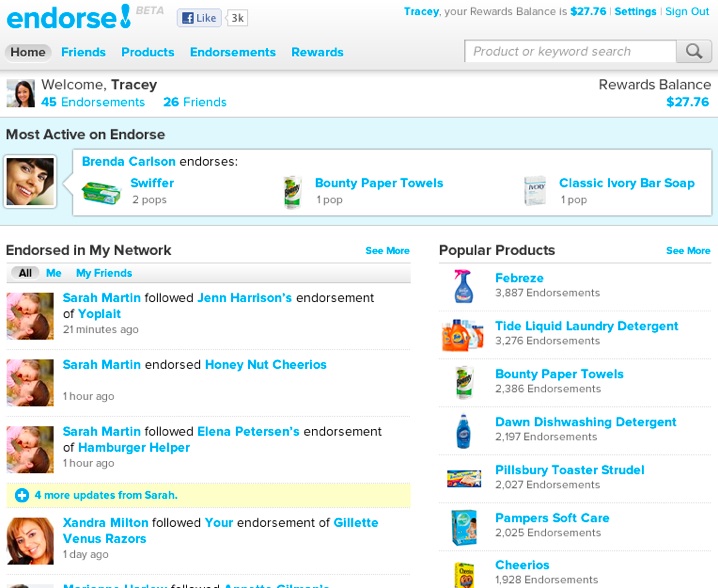Brands and businesses can track their reputations online and connect with consumers through social media. But what about in the real world? One of the biggest prizes in Startupland will go to whoever can figure out how to connect real-world shopping to brands and businesses. Steve Carpenter is going after that prize with his latest startup, Endorse.
A lot of effort is going into trying to close the redemption loop from online offer to physical purchase in real-world stores. The daily deal sites like Groupon and LivingSocial are nibbling at this, as is Google Offers, Yelp and others. Most of those efforts focus on local commerce rather than big brand products you buy at national retailers, and that’s the nut Carpenter wants to crack. “If I look around, certainly Groupon created a new kind of incentive for local merchants, but nobody has modernized the coupon for the modern brand.”
Carpenter has been incubating the company for a year as an entrepreneur-in-residence at Accel. (He sold his last company, Cake Financial, to Etrade in 2010). Endorse just raised $4.25 million in a Series A led by Accel, with SV Angel also investing (it fits into SV’s Online2Offline investment theme). His co-founders and team include early employees from YouTube and Paypal—co-founder and CTO Erik Klein, Mayrose Dunton (YouTube’s original head of product), and Franck Chastagnol (former lead engineer for YouTube ads).
“The coupon turns 125 years old this year,” notes Carpenter. “It was designed by the first Coca Cola CEO—it was a free trial. The mechanism of the coupon hasn’t changed.” Endorse is trying to reinvent the coupon by rewarding shoppers (mostly networked Moms) for not only endorsing brands, but proving that they went out and bought the products.
Carpenter tested out his concept in classic Lean Startup fashion. During a 3-month private beta trial, shoppers went to Endorse.com to pick the brands and products they liked, and then actually sent in their receipts for 10 percent cash back. Endorse sent them a Netflix-like mailer, and they stuffed it with receipts. Endorse set up a scanning process to scan the receipts and record their purchases. In addition to the cash back, brands could reward loyal customers with discounts for themselves and their friends.
The results of this market test were fairly impressive. Endorse seeded the service with five women across the country. With no marketing, it spread to 15 thousand beta customers in three months (86 percent of them women in places like Indianapolis, North Carolina, and Sacramento). Just like Pinterest, Endorse kept this stealth by focussing on middle America.
Those 15,000 customers turned in 150,000 receipts and made 1.5 million brand endorsements. By the time Carpenter ended the trial, the service was growing by 10,000 receipts a week. These numbers are small, but that’s the point. He and his team learned enough about their customers to start designing the real product, which will launch later this year.
The real product will still include the Netflix for receipts, but there will also be a mobile app which will allow consumers to snap a photo of their receipts instead of mailing them in. Endorse tested this as well using just camera phones and email, and it was seeing a new proof of purchase pop in every 90 seconds over a period of 3 days.
Endorse is trying to solve two problems: recognizing shoppers for product loyalty and giving brands product-level data currently unavailable to them. In addition to cash back, brands can use Endorse to craft other types of incentives, such as paying extra to get you to try a product. Or, if you are Oral B, you know that someone who buys a set of replacement heads for a spinning electric toothbrush is 90 percent likely to remain a lifelong customer. It might be worth it to reward that person $25 or even $50 for making that critical purchase. Or a loyal customer might get a nudge to influence her friends by letting her gift them a 30 percent discount. Endorse can also lead to buying circles. Each endorsement can be shared via the equivalent of an affiliate link for the real world, which then associates the new Endorse members to the person who referred them.
For brands, it is all about the data. Most real-world retailers are stingy with the data they share with brands about who is buying their products. Web startups like Endorse see an opportunity in bypassing the retailers and simply connecting brands and consumers directly. But that is easier said than done. You might remember that previously social shopping startups such as the defunct Blippy tried to get consumers to broadcast their credit card purchases on Twitter or Facebook with the intention to later pan in that stream for data nuggets. The challenge was that nobody really wanted to broadcast how much money they were spending, and even if they did, the data wasn’t at the product level, it was at the basket level.
Endorse collects the actual receipts, with each product listed line-item by line-item. It’s a printout of the retailer’s cash register information, which Endorse then scans and redigitizes to put back into its own database. It is an inefficient process, but barring big retailers like Walmart and Target opening up their data warehouses to brands and startups (ain’t gonna happen), the physical receipt in the customer’s hands is the only way to reassemble that data. It’s somewhat of a hack, but if Endorse makes it easy enough it could have a business.
All it is doing, if you think about it, is liberating data. There is a lot of money to made from doing that these days.

